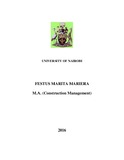| dc.description.abstract | This research project examines Appropriate Technology (AT), which has been popularised in Kenya for well over thirty years apparently without meeting the desired results of exponential increase in uptake of its products among the target population. It first examines the rationale and need for AT in construction generally and in Kenya in particular. It then looks at the prevalence of factors that have contributed to the adoption of the technology on the one hand and those that have inhibited its growth on the other hand.
The study utilises the Compressed Stabilised Earth Blocks (CSEB), one of the best known products of AT locally to demonstrate the kind of challenges the technology has encountered in the Kenyan context. It discusses literature pertaining to the materials under study starting from the global to the local context, giving an understanding of the material itself and its merits and demerits. The literature also gives a pointer as to the likely areas to be examined in the local context to be able to pinpoint weak points to sustained growth in use of CSEB.
The study employs research methods, tools and instruments relevant to the kind of study to give insight into the material itself and its uptake. Through a survey of the identified stakeholders that can influence the uptake of AT products, the study reveals perceptions as to which category stands a chance to have a great influence in the growth or stagnation of use of CSEB. It also employs techniques of direct observation, interview of key participants and questionnaires to sample populations of stakeholders to give a holistic picture pertaining to the situation analysis of the materials technology in question.
The findings from the study are examined against the background of what has been gained through literature. Some findings seem to be in line with available literature whereas some appear to deviate from what is known. Through these, the researcher contributes to the body of knowledge concerning the object of study and opens up the
v
subject for study by others. Findings point to public awareness of the material being low given that mass media is not the main sources of information concerning the material, perhaps the reason why the target population is yet to be tapped into.
Based on the findings from the study, recommendations are drawn first and foremost as to whether the technology needs to be promoted any more or abandoned altogether. The study reveals that AT is still relevant to the national aspirations, based on practical considerations of the impact it can have on the supply of materials for construction to a large sector of the population. Also, the study recommends what needs to be done to enhance growth of ABMT in Kenya, how it is to be done and who exactly is to carry it out. The national and county governments are still perceived as not doing enough to promote use of ABMT and, by use of resources at their disposal, they can positively influence the use of CSEB and other forms of ABMT in construction.
It is the hope of the researcher that the conclusions that are reached within this paper will have the impact of enlightening current and intending users of products of this technology. Further, by implementing recommendations contained herein, it is probable that the full potential of ABMT will be realized, bringing with it the economic benefits envisioned by the founders of the Appropriate Technology movement. | en_US |



